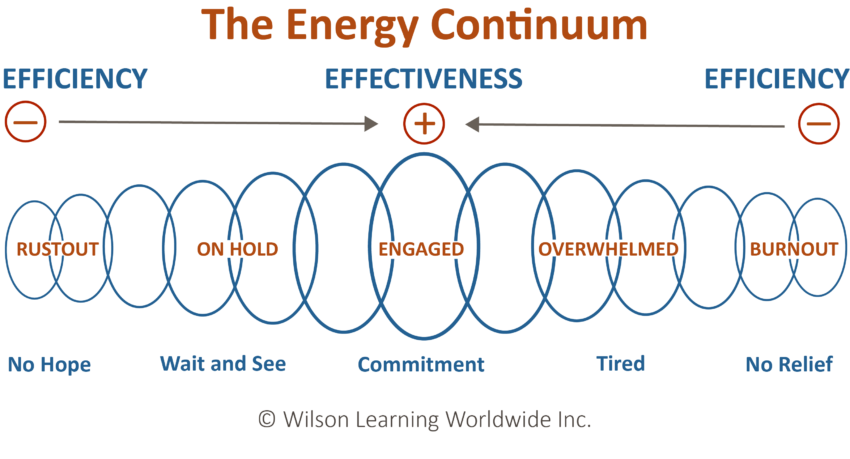It seems there are two types of disgruntled people in our current economy: those who don’t have jobs and those who do. Why? Because for each person who has left an organization, the ones left behind are working harder, feeling overworked and underappreciated, and often being underpaid. Almost everyone in the workplace has been “doing more with less” for a long time. Yet productivity has risen 2.3% annually during these tough times, according to the Bureau of Labor Statistics. This increase is due to fewer employees working more hours and taking on bigger workloads. This is good news for CFOs and senior managers, but it comes at a cost. The dark side of productivity improvement is that people are stretched too thin. Many employees have reached the point of burnout and are no longer able or willing to give their all every day. The last flicker of discretionary energy has, in many cases, been spent.
But can you get higher productivity without burning people out? Our experience says “yes.”
 As the model shows, employees with low engagement passively wait to see what comes next. If they perceive no chance for improvement, they slip to the left on the continuum to the state of “rustout,” with “no hope.” On the opposite extreme, some people are so committed they take on impossible workloads only to become overwhelmed. They reach a point of “burnout” as they experience “no relief.” Efficiency is at its lowest ebb in the states of rustout and burnout. Efficiency is maximized when employees manage their discretionary energy carefully, allowing them to stay highly engaged near the point of equilibrium—at the midpoint on the Energy Continuum.
As the model shows, employees with low engagement passively wait to see what comes next. If they perceive no chance for improvement, they slip to the left on the continuum to the state of “rustout,” with “no hope.” On the opposite extreme, some people are so committed they take on impossible workloads only to become overwhelmed. They reach a point of “burnout” as they experience “no relief.” Efficiency is at its lowest ebb in the states of rustout and burnout. Efficiency is maximized when employees manage their discretionary energy carefully, allowing them to stay highly engaged near the point of equilibrium—at the midpoint on the Energy Continuum.
As the continuum illustrates, employees need to see changes that offer hope of relief and renewal in order to re-engage and avoid the results of burnout—reduced efficiency, lowered productivity, and decreased commitment.
Most managers can’t guarantee more headcount any time soon. If hiring is out of your reach today, what can be done to renew your team’s sense of engagement and commitment? While there are no magic bullets, there are strategies that can help your overextended team members re-engage with each other and their work.
Delegate for Growth
It seems paradoxical to talk about delegation in this context. Give them more work? No. Rather, take a good hard look at what is being done today and who is doing it. Ask yourself, what is being done that doesn’t really need to be done? What is being done a certain way because it’s always been done that way? What isn’t being done that should be done? You may be able to increase capacity with the right mix of new assignments and growth opportunities for your people.
Assess Your Team
- Review the current workload and capabilities of your team members.
- Identify areas in which individuals can develop new skills and knowledge for growth, or apply existing skills in new ways.
- Identify unused or underused capabilities and skills that could be put to use on different tasks or priorities.
Assess the Workload and Look for Opportunities to Change How Goals Are Being Accomplished
- Look for tasks that are no longer tied closely to strategy or that can be done in a different way. It is easy to fall into a rut where things are being done because they have always been done or have always been done a certain way. By looking at tasks with fresh eyes, you may see that tasks or processes are tied to an old business model or strategic intent and don’t need to be done at all. Some of the work could be done very differently—with the use of technology, for example.
- Reassign necessary tasks to new people and give them authority to do the tasks differently. The opportunity to be creative and change what’s always been done raises the importance level of the task and provides a chance to do it more effectively.
- Look for new, interesting projects that will provide an opportunity for the right people to do something new, expand their skills, and work with different people—possibly across functions. Again, there may be opportunities to apply technology, change a method or process, or make improvements that increase efficiency or productivity. These are satisfying contributions that could have the effect of increasing capacity and fulfillment.
Tips for Success
As you expand horizons with new assignments and projects, keep in mind the Delegation 101 rules of thumb:
- The task is seen as a challenge and an opportunity to grow and learn new skills rather than as another burden. The whole effort will backfire if people see this initiative as just more work.
- The goals and expectations are clear and achievable. People working on new tasks or projects need to see they can be successful in carrying out the new tasks or projects.
- Support and resources are clearly available. There is nothing worse than being given a task to do without the resources to meet the goal. Ensure there are enough people to do the job, the right equipment is available (e.g., computer software), or (if required) a budget has been allotted.
- There is an appropriate level of autonomy in deciding how to carry out the assignment. Again, the idea here is to empower and engage your team. They need to feel they are being trusted, are free to exercise their judgment and apply their ideas, and are empowered to make decisions and take action. Be ready to provide help without micromanaging.
As with any change, discuss your ideas with the team and gain the support and agreement of the individuals who will be taking on the new responsibilities.

